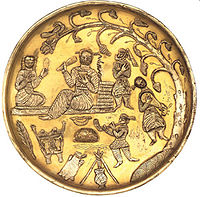

Sasanian music encompasses the music of the Sasanian Empire, which existed from 224 to 651 CE. Many Sasanian Shahanshahs were enthusiastic supporters of music, including the founder of the empire Ardashir I and Bahram V.[1] In particular, Khosrow II (r. 590–628) was an outstanding patron, his reign being regarded as a golden age of Persian music.[1]
Persian classical music dates to the sixth century BCE; during the time of the Achaemenid Empire (550–331 BCE), music played an important role in prayer and in royal and national events. But Persian music had its zenith during the Sasanian dynasty from 224 until 651 CE. In this era, many of Persian music's dastgahs and modes were invented, most of them traditionally attributed to Barbad. He employed 30 sounds for music. Naturally he recorded his inspirations and performed them for his audience, since if he did not, he could not play them again.
Dance and chanson were prevalent in court banquets. It said that on several occasions Persian musicians and dancers were given to the court of Chinese emperors by Sassanid kings, implying the high reputation and virtuosity of Persian musicians and dancers in that era. Another important role that music played was in the reception of foreign diplomats and kings from neighbouring countries, such as Byzantine or Hephthalites.
Five centuries after Barbad's death, Farabi made a record of all the musical pieces of his period and described the ancient note recording method.
- ^ a b Lawergren 2001, "5. Sassanian period, 224–651 CE.".